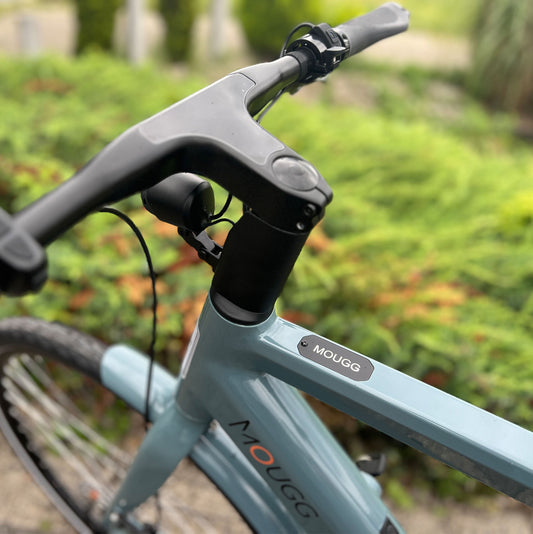
Kette oder Riemen?
Share
Mehr zum Thema Kette- und Riemenantrieb
Für wen ist ein Riemenantrieb ideal? Ist die Kette oder der Riemen besser? Welche Vor- und Nachteile hat ein Riemenantrieb und ein Kettenantrieb?
Es gibt keine eindeutige Antwort darauf. Während einige Radfahrer die Gefahr eines gerissenen Riemens kritisieren, schwören andere auf die lange Haltbarkeit und einfache Wartung des Zahnriemens. Sowohl die Kette als auch der Riemen haben ihre Vor- und Nachteile. Eine individuelle Abwägung ist erforderlich, um zu entscheiden, welche Option die bessere Lösung für das eigene Fahrrad darstellt.

Wie funktioniert der Riemenantrieb?
Statt einer herkömmlichen Fahrradkette wird bei einem riemengetriebenen Fahrrad ein Carbongurt eingesetzt, welcher an der Innenseite mit Nylonzähnen versehen ist. An der Kurbel befindet sich eine größere Riemenscheibe, während die zweite Riemenscheibe etwas kleiner und an der Hinterradnabe befestigt ist. Der Zahnriemen wird zwischen diesen beiden Zahnscheiben gespannt, sodass die Zähne des Riemens und der Zahnscheiben ineinandergreifen. Bei korrekter Spannung wird kein Durchrutschen ermöglicht.
Für wen ist ein Riemenantrieb ideal?
Es gibt viele Gründe, warum ein Riemenantrieb für viele Menschen sinnvoll sein kann. Insbesondere die geringe Abnutzung und damit verbundene längere Lebensdauer des Antriebs ist ein wichtiger Faktor. Dies kann insbesondere für Vielfahrer von Interesse sein, da ein regelmäßiger Austausch von Kette und Ritzel nicht mehr erforderlich ist.
Zusätzlich zu den bereits genannten Vorteilen bietet der Riemenantrieb auch geräuschlose Fortbewegung und eine geringere Reibung. Im Gegensatz zur Verwendung von Kettenöl oder -fett ist der Riemenantrieb völlig sauber und kann beispielsweise ohne Probleme mit einer Anzughose gefahren werden.
Riemenantrieb Vor- und Nachteile im Überblick
Vorteile
-
pflegeleicht
-
bei richtigem Umgang lange Haltbarkeit
-
bei korrekter Riemenführung keine störenden Geräusche
-
Riemen ist deutlich leichter als eine Kette
Nachteile
-
keine Reparatur des Riemens möglich
-
Ersatzteilbeschaffung gestaltet sich schwieriger
-
Nicht einfach zu transportieren, da bei falscher Kompression wie Knicken, die Gefahr von Schäden gegeben ist
-
Risse und andere Mängel sind schwer zu sehen
-
Beim Hinterradausbau muss der Antriebsriemen neu gespannt werden

Bei niedrigerer Trittfrequenz kann die Kettenschaltung in technischen Messungen effizienter sein, aber in der Praxis spüren Radfahrer in der Regel keinen Unterschied in der Reibung. Der Riemenantrieb kann jedoch durch Schneematsch und Schmutz stark beeinträchtigt werden, was bei Winterfahrten berücksichtigt werden sollte.
In Bezug auf die Sicherheit ist der Riemenantrieb aufgrund der Schwierigkeit, Risse zu erkennen, möglicherweise gefährlicher, da ein gerissener Riemen ein höheres Unfallrisiko darstellt. Für Fahrradfahrer, die ihr Fahrrad oft auseinanderbauen, um es im Auto zu transportieren, ist ein Kettenantrieb möglicherweise die bessere Wahl, da nach dem Ausbau des Hinterrades die Riemenspannung neu eingestellt werden muss, was Zeit und Aufwand erfordert.
Kettenantrieb Vor- und Nachteile
Vorteile:
-
keine Einstellungen nach dem Ausbau des Hinterrades erforderlich
-
weniger empfindlich gegenüber äußeren Einflüssen
-
Ersatzkette einfacher und günstiger zu beschaffen
Nachteile:
-
Wartung ist ohne Kettenkasten aufwendiger
-
geringere Haltbarkeit
-
schwerer im Vergleich zum Kunststoff-Riemen
-
Knacken oder Klappern bei schlecht gepflegter Kette
-
Ohne Kettenschutz verschmutzte Hosenbeine




